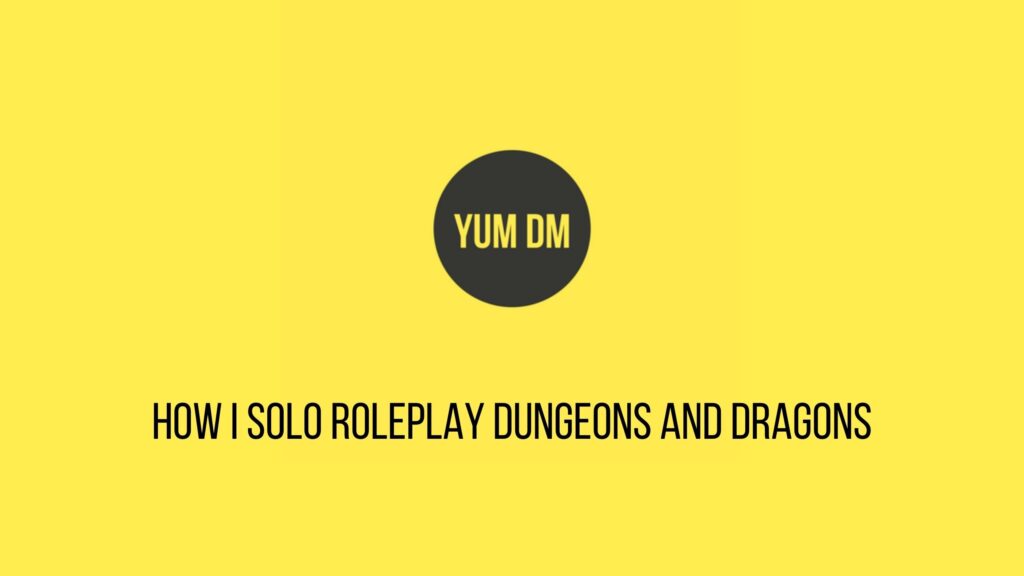
This will show you how I solo roleplay (or SoloRPG) my D&D campaign.
Note, this is not an article on how you should solo roleplay, but simply how I do it.
A lot of people solo roleplay, but they all have one thing in common: they play a different way.
If you like the way I play and would like to do it the same way then great! Otherwise, you may find some useful tips to help you do it your way.
Also, keep in mind I usually solo roleplay with D&D 3rd edition these days, but most of what follows can be used for any system.
Stuff I Generally Use:
-
-
- D&D 3rd edition PHB & DMG (or any rulebook of your favourite fantasy RPG)
- D&D 3rd edition Monster Manual
- A book filled with my own random tables
- Donjon random dungeon map generator on the laptop or mobile device
- Character sheets (I use traditional paper ones)
- Campaign book (grid-lined) for maps and notes
- Dice
- Pencils
-
Miniatures or No Miniatures with Solo Roleplaying
I also sometimes use minis and some dungeon grids as well.
I find minis fun to use sometimes, but they are a hassle other times.
I find I can solo roleplay just about anywhere if I simply use a grid map book and a pencil to show where each character and the monsters are, rubbing them out and redrawing them as they move.
Once everything is laid out how I like it, I get started.
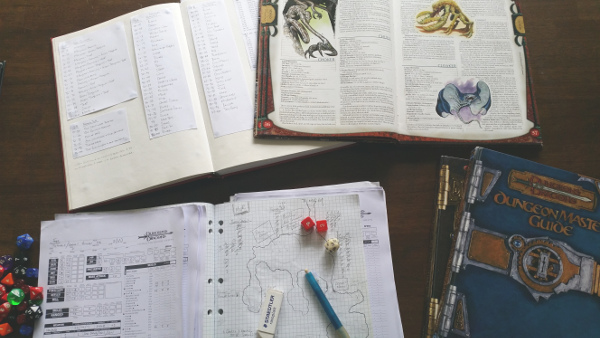
Journal
I keep a dot-point journal of sorts using Google Drive that tells me what has happened in previous sessions (entries are categorised by date) so I usually take a quick read of that so I know where everyone is and what they are doing.

This journal helps me immensely as I run continuous campaigns in the same campaign world, so this allows me to keep track of what everyone is doing and what has happened.
It’s also just fun to read back as I forget a lot of what has happened in the past.
I keep one of these journals for each campaign I’m running (which is about six currently) and keep each campaign in a separate folder on Google Drive.
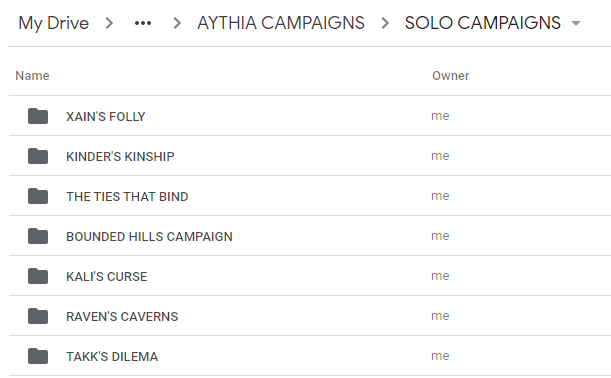
Party Size in Solo Roleplaying
Some of my campaigns have only one character, some have two, and some have a whole party of six or more characters.
This is one of the great things about solo roleplaying – you can have characters stop adventuring with the main party and go off and do their own thing at any time.
I have done this extensively with my main Xain’s Folly campaign, which has characters coming and going all the time.
Some sessions involve only some of the characters and some characters have left the city where it takes place and I run that as a separate campaign – spinning it off into its own campaign.
Much like TV shows do with spin-off shows (Buffy and Angel come to mind).
I also keep a spreadsheet detailing the dates of each of the campaigns – this is important as it allows you to keep track of who is doing what and when, and shows you where a particular character is on any given day.
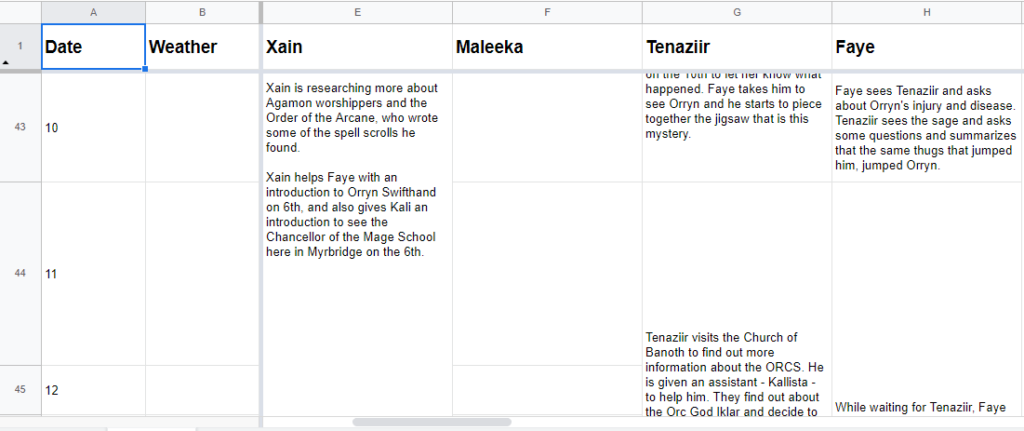
I usually know which campaign I am going to run ahead of when I set up, so I have all the character sheets I need in front of me.
I leave off where I finished in the last session, whether that’s with the PCs in the dungeon, travelling, or having a rest or downtime.
Getting Started with Solo Roleplaying
Getting started is probably the hardest part, but once you get going I find it gets easier.
As a side note, I think this is one reason I prefer long-running campaigns as opposed to one-offs. When you keep running one-offs, you need to restart every time, which I do find frustrating and laborious if I have to do it too often.
I usually start a brand new campaign in a section of my campaign world that I want to flesh out or explore more.
Once I have chosen an area, I create a focus.
Focus
A focus is a reason for adventuring.
So, in my main campaign, Xain’s Folly (I like giving my campaigns names as well), the premise was simply:
Explore the Deep tunnel system under the city-state of Myrbridge.
That’s it.
From there it has grown into a life of its own (more on that later).
Having a mission for one or more of the characters is vital as it will guide you at the beginning.
And this goal could be as simple as “explore the ruined village” or “delve the ancient elven tomb”.
The latter was the premise for my newest campaign involving six brand new first level characters.
I set this in the northern frontier area of my campaign world and from a small town (this makes a good base for the characters to come back to and allows you to get started quicker – just don’t worry about fleshing it out at this stage) the party of six set off to delve the ancient elven tomb.
All I mentally prepared beforehand was that it was a tomb, it was elven, and the entrance was located inside an ancient dead tree trunk.
I also knew this entrance was a day’s journey from the town so I could make it back to town in one day if needed.
With just this, and my characters, I started with the journey there (with no encounters), and the first “chamber” of the dungeon: the hollowed out tree trunk entrance.
There I rolled an encounter: four dwarves.
I had also randomly determined the weather (ahead of time) and knew it was raining heavily by the time the characters reached the tree.
Inside, seemingly seeking shelter from the rain, were four dwarves.
I rolled their alignment and also what they were doing there (see Understanding the Why in Solo Roleplaying, below on how I do this). It turns out they are evil and part of a cult.
The PCs made themselves known to the dwarves, but a poor reaction roll meant the dwarves were suspicious of them and attacked immediately.
A lucky strike by the fighter and the head dwarf cultist was cut down and, with their leader dead, the other dwarves failed their morale roll and surrendered.
The characters ended up letting them go, not knowing what else to do with them.
Understanding the Why in Solo Roleplaying
In the example above I mentioned I rolled to see what the four dwarves were doing in the ancient tree trunk.
I do this by consulting one of my much used tables, which is from The Solo Adventurer’s Toolbox by Paul Bimler.
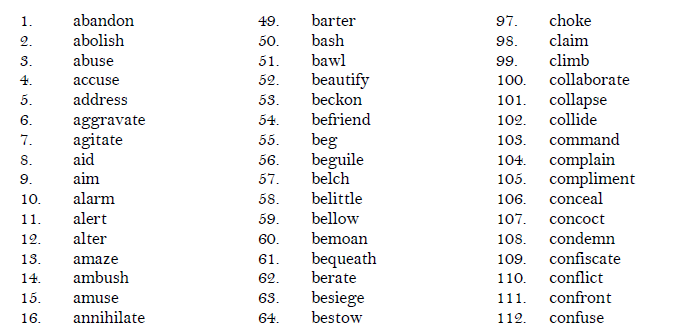
Paul calls it the Situations Table, but in reality is just a big list of 500 verbs.
And I cannot recommend this (or something like it) enough for your solo roleplaying experience.
You can randomly roll at any point to help you or guide you into understanding what is happening with NPCs, items you find, places you visit, or even the history of your campaign world.
I have used it for all of the above on multiple occasions.
I use the table by rolling three times to give me three random words from which I build a story.
For the dwarves above, I rolled the following:
Banish | Betray | Victim
Once I have my three words I mentally start weaving them together into a story. This is where you need to get creative (and, like anything, the more you do this, the better you get at it).
I turned this into the following:
The four dwarves are members of an evil cult who want to kill the current leader (betray) of their dwarven clan and reinstate the former leader who was banished (banish) for crimes against the dwarven empire (victim).
The dwarves were checking out the elven ruins as they heard rumours there could be magical items there that could aid their mission.
Ongoing Campaigns Build Momentum
The campaigns I am running currently have a life of their own these days – the missions and adventures pretty much generate themselves – I just need to decide which I focus on.
For example, the main adventuring party was exploring the Deep tunnels under a city-state called Myrbridge, and while they were trying to track down an evil NPC party (made up mainly of Dark Elves), the priest – Tenaziir – discovered a plot to poison the city’s water supplies by a bunch of zealot orc clerics who worshipped the god of disease.
Back topside in the city, while he was researching more about this plot, Tenaziir was set upon by a group of human thugs (which was a randomly rolled city encounter).
These thugs turned out to be in league with the orcs, and suddenly Tenaziir realised this wasn’t just the mad machinations of random orcs, but a larger threat to the city from within!
As you can see, encounters within the tunnels beneath the city take on a whole new life of their own and generate an endless supply of adventures.
The only part of the above that was planned from the beginning was the idea of exploring the tunnels under the city-state, which was the premise I had when I first started.
The rest came once the encounters were randomly rolled for.
Player and GM Decision-Making
If the characters are on a mission I, the player, decide what they do next.
Sometimes this is obvious, while other times not so much, so I will really need to think about what their next move will be.
I also, as GM, need to decide what any major NPCs do.
Using the water poisoning example above, the Big Bad ended up being the head priest of Tenaziir’s own temple and once this was discovered, and the Big bad knew that Tenaziir knew, I had to decide what both were going to do about it.
For the player, this was as easy as me – the player – deciding.
For the GM, it was a little more detailed.
And this is where I use an Oracle.
My Simple Oracle
I use a simple D6 Oracle as I find complicated Orcles charts just not necessary.
-
-
- No, and
- No
- No, but
- Yes, but
- Yes
- Yes, and
-
I have to thank Jon from Tales of the Manticore for giving me this simple chart. And you can find out more about it, and various ways to use it in a more recent article I wrote focused on the D6 Oracle.
I generally suggest courses of action that I think would be inline with the NPC’s motivations, personality and resources, and then roll on the Oracle chart above.
Given the Oracle is a yes/no machine, I have to phrase my questions in a particular way.
When the ‘yes, but’ or ‘yes, and’ (or the ‘no’ equivalents) come up I usually go with the first thing that pops into my head.
Using the example above, with the head priest, I thought he would do one of two things: go into hiding or try and kill Tenaziir.
I simply asked: “will he go into hiding?”. The answer was ‘no’.
The next question I asked was: “will he try and kill Tenaziir?”. The answer was ‘yes, and’ and my first thought was assassin. And so, I came up with the head priest’s action as hiring an assassin to kill Tenaziir.
Once I find out what the NPC will do I put that plan into play.
Character Knowledge Vs. Your Knowledge
Obviously, I need to keep that knowledge separate from what the character knows, and sometimes this can be difficult to do, but it is a part of solo roleplaying and you just need to do your best to be fair-minded.
If I am not sure if a character would know something or not, I usually get them to make an Intelligence check to see if they would reasonably know it.
This could easily be a Charisma check for social situations, or a Wisdom check for perceiving something, but I find I use Intelligence more often than any other check in this situation.
But don’t over use this – sometimes a character just couldn’t possibly know something. So don’t use it as a metagaming tool.
3 Parts to Solo Roleplaying
There are three broad parts to solo roleplaying that I want to cover. They will probably be familiar to you: dungeon crawling (exploration), roleplaying, and travel.
I have split them out like this as I tend to handle them all differently.
Dungeon Crawling
At the moment, dungeon crawling is a big part of my solo roleplaying adventure.
This is mainly because the main campaign’s focus is on mapping and clearing out the mega-dungeon located under the city-state of Myrbridge.
In other words, I spend a lot of time in the dungeon.
The first thing you need to decide is how you will generate the dungeon map.
Dungeon Map Generation
I have experimented with a few options (and still use several different ones on occasions) but the one I use most is Donjon’s random dungeon generator.
I set the parameters up to generate a natural, diminiutive cavern and then just add that on to my already existing map, rotating it as required.
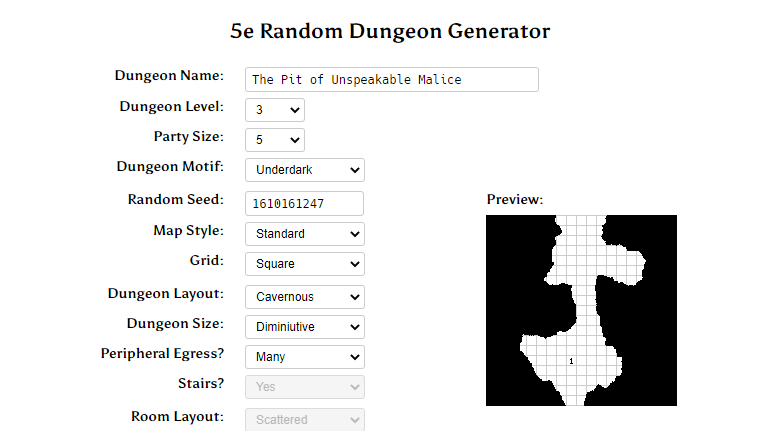
I ignore the dungeon level and party size as I don’t use the actual encounters it generates (although you easily could).
The map it creates for me looks similar to this:
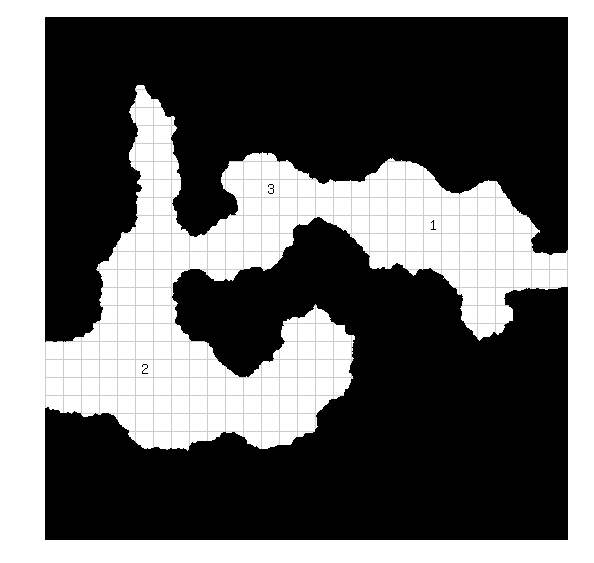
This will give me 2-3 connected chambers to explore, which I add to my existing map.
Once I have a map of the area, I roll to see if there is anything in the chambers.
Generating Encounters
For this I use my own random table that is based heavily on the one from the D&D 3rd edition DMG.

I use this one as it gives a good range of monster encounters, as well as traps, treasure, or nothing at all (or maybe just some structural features).
Depending on what I roll on this chart, I have created a bunch of sub-tables for what I find.
So far, this has worked well for me.
For monster encounters, I tend to use the ones out of the D&D 3rd edition DMG, which have a number of tables based on the level of the dungeon.
Once you know the level of the encounter, you can roll on the appropriate sub-table.
For example, at first level, if you roll badly, you could end up facing off again a level 3 monster!
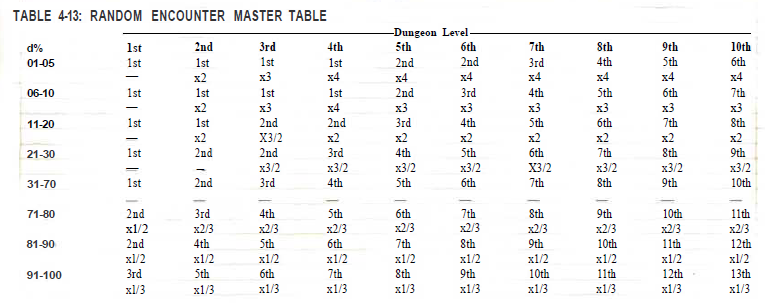
This isn’t perfect, but it does the job for now.
If a monster is located in the chamber, I read all about them in the Monster Manual (or wherever), and then (assuming it’s not just a mindless being) roll their story and motivation using the word table from The Solo Adventurer’s Toolbox.
If it’s a bunch of sentient creatures or NPCs, I roll up their class and race and, once again, use the word table to discover what they are doing there.
At the end of this whole process (which is pretty quick once you get used to it), I have the following:
- A map
- What the next chamber contains
- A well-rounded encounter
I then play through the combat or interaction with my characters.
If the encounter is with a monster or group or NPCs, then I will use a reaction roll, adding any Charisma adjustment for the lead character.
For this I use the following chart from the D&D Red Box set:
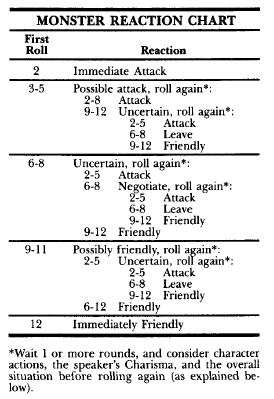
I like this chart as you need to roll three times. I do the initial check and then, based on that roll and what the characters do or say, I roll again with a new adjustment, and then repeat for the last roll.
Each time, trying to roleplay it out in my head.
This is a nice segue into the roleplaying component of solo roleplaying.
Putting the Roleplaying in Solo Roleplaying
I tend to roleplay in two places: at the table and when out walking.
If I have enough time, I will roleplay interaction at the table, but usually, I don’t have that much time to sit down and roleplay, so I do most of my roleplaying in my head (sometimes even talking to myself out loud) as I walk from place to place.
I find this helps creativity as well. There is something about getting outside and walking that gets my creative juices flowing.
I also find talking out loud to yourself very helpful. Sort of like a solo sounding board.
I will roleplay PC and NPC interactions this way, but I will also think about the characters and what they would do in a particular situation.
When it comes time to roll some dice – for reactions, Oracles, or skill checks – I usually pause it and wait for that outcome.
If it’s just a simple Oracle roll, sometimes I will use the dice roller on my phone, but in most cases I will wait until I get home and roll some real dice.
The roleplaying part is important as it drives the story forward. Based on what NPCs do or say and how they react to the characters, it will give characters new opportunities or create roadblocks.
A good example of this is when Faye, my ex-mercenary (Fighter/Rogue), fought a Githyanki warrior and wanted to find out more about the Githyanki fighting style. She asked Xain (another character) if he knew of anyone who would know and Xain introduced her to an NPC – a sage of sorts who had studied the fighting styles of planar creatures.
Faye discovered that the sage was dying from an unknown disease after being attacked by some thugs. Faye went to Tenaziir (the party’s cleric) and they quickly made the connection to the aforementioned plot involving the thugs and orcs, and decided they needed to not only save the city but find a cure for this sage.
They ended up doing both, and the sage is sharing his knowledge with Faye on the Githyanki.
GM Executive Decisions
Tying originally separate plots together like this is a great way to bring the campaign to life and really make it seem like it was planned like this all along.
Tying it together like this does take some hard decisions on your part though.
No roll directed me to combine the plots – it just seemed cool to do so. And made sense and was cool, and so I made it happen.
This is where your GM hat is firmly on your head and you get to make executive decisions.
Not every decision is rolled out or from a random table. Sometimes you just do something because it fits in with the story.
Travel
I haven’t done a ton of travel in my game (yet) – it’s mostly been exploring dungeons and spending time in one city, but I will go over what I have done.
In the past I have hand-waved travel between settlements, but I think this is a mistake.
Like in dungeon exploration, encounters along the road or in the wilderness can have a huge impact on the story of the campaign. And even lead it in new and interesting directions.
I tend to check for random encounters four times a day: morning, midday, afternoon, and night.
If the journey is less than a day, I may do hourly checks, but this hasn’t come up very often.
And depending on the location, the encounter chance varies.
I need some more comprehensive tables for these sorts of encounters. I like having separate tables for each location, based on the relative safety of the area (more established versus frontier lands, for example) and to showcase what animals, peoples, and monsters might be in a particular area.
For example, the encounters in one forest would be different from another forest, even in the same region, as they have a different ecosystem and different threats.
But, currently, I tend to use random tables from a variety of sources, including older editions of D&D, tables off the internet, and some I have created.
(This goes for dungeon crawling as well.)
Not all the encounters are monsters, either. Or are life-threatening to the party.
Some, especially those along the roads, are merchants, messengers, and other non-threatening travelers.
The PCs can interact with these encounters and gleam information off them and just have a chance to roleplay.
One example stands out to me as a good traveling encounter was when Aeros, my conjurer (well, illusionist, but don’t tell anyone), was traveling from his home town to a druid’s grove to the south.
The journey would only take a day and was across some grassy plains. I managed to roll an encounter. Unfortunately, for Aeros and his young companion (a wannabe Druid 0-level NPC who was guiding him), the encounter was a pack of wild dogs.
I made these Wild Prairie Dogs, who were local to the area, and who had a penchant for following prey for days and even weeks.
A small number of these wild dogs attacked the two travelers and the NPC was knocked out almost immediately. Aeros killed two of the dogs and scared the others off with his magical fire.
Aeros continued south, carrying the unconscious girl, and the dogs were following close behind, sensing a weakened target. Aeros luckily reached his destination before they attacked again, and the Druid calmed the wild dogs and they left peacefully.
This was a fulfilling encounter as not only was it a cool little combat that only lasted two rounds, but it added something to the world – mainly, it added that wild prairie dogs are a menace to travellers south of the town.
Which I can now add to my random encounter chart for that area.
It also led to a nice introduction of the druid and a good roleplaying scene where Aeros had to convince the druid to help him, which was no easy task.
As you can see, roleplaying can lead to any number of places for the character to travel to (or from), things to find or retrieve, and so on.
They are a vital part of any solo roleplaying campaign, so don’t hand-wave it just because there is no-one else to roleplay with.
Bringing it All Together
All of the above took time.
I didn’t have it all figured out at the very beginning – and neither do you.
I added and changed parts a lot, and I am still doing this.
I am making up more detailed and accurate random encounter tables for each region of my world, I am getting better at keeping track of what’s happening, I am tweaking rules and processes all the time.
So don’t wait for perfection, it won’t come. Just start and change as you go.
Just start simply with your favourite rules system, a couple of characters, a small dungeon, a simple Oracle, and a random encounter chart; and then let your imagination take over.
And if you don’t like something, change it. It’s only you you have to please, and no-one else needs to know (unless you write an article about it).
Over to You
Have you solo roleplayed before?
I would love to know if you found any of this helpful, and how you solo roleplay.
If not, does this help you get started? Any questions, let me know in the comments below.
You can find me posting quite a bit over on Twitter.
While You’re Here…
Since 2021 I have been publishing d12 Monthly, a monthly zine, which has a ton of articles for any edition of Dungeons and Dragons.
Printed copies are available in my store. The PDF is available on DriveThruRPG and you can get both, plus support my work, via my Patreon.
I will also be releasing some more products in the near future.
Feel free to reach out to me on Twitter or my contact page any time.

I am curious how you defined the dates of the adventure (time tracking) for your solo play journal.
Not sure exactly what you mean, but will try an answer it. The calendar is one I created myself, with 12 months of 30 days each, plus some festival-type days. I track time as adventures progress, so arbitrarily. Time is tracked carefully and records kept (in the journal and spreadsheet) so I can keep track of each campaign and where everyone is at any particular time. This is due to some characters spinning off into solo or duo adventures from time to time.
I have been thinking of doing 1 day real time = 1 day campaign time, but I don’t play regularly enough to have this make sense, and I think the way that I do it now works well enough.
When I play I find that certain characters need a lot more downtime than others (mages, for example), but other classes also have things to do. Travel takes some time so it can take characters a bit of time to get from place to place if they need to travel to meet with someone.
I really like the time aspect to the campaign, and keeping track of it, as (at least for me) it adds a lot more depth to the campaign and really makes me think these are real people with real things to do – adventuring just being one of them. A means to an end for many of them.
I hope that answers your question, and helps.
Thank you, that clarifies some things. Just one more question, did you define the starting day of the campaign randomly? Like, this party is starting at day XX of Specific Month of XXXX in this world. This time tracking is something I want to do in my Solo game so far I’m just taking note of the passing days but no date or calendar associated to it.
Thinking back I believe I started on the first day of Spring – I did this as during the winter months not a lot of travel happens, especially in the north, as the snow and colder weather sets in. This way I have all of Spring, Summer, and Autumn to adventure. 🙂
I would recommend creating a calendar – I made mine very “Earth-like” so it was easy enough to understand and I didn’t want to confuse players or myself with a system that was too unfamiliar. I named the months after the 12 Major deities in my campaign world. And three fit into each season, which kind of represents them (the Sun god in summer, etc).
Hope that helps. If you do come up with something, let me know – I love seeing what over people come up with.
Fantastic, that’s super helpful. Thank you
You are more than welcome. 🙂
I just decided to make a lunar calendar, first because I like the moon, but I am often playing magic-users and that fits in their knowledge base, I also feel like it gives a magic vibe to the time tracking and my character in role-play and interaction with NPC make references to time and seasons, so I feel like it’s easier for them to account for the moon changes than to fit into a solar calendar. So I defined a 13 month year with 28 days each month. Every month starts on a black moon (new moon) and ends with the moon “dying” (waning moon).
Sounds awesome! I really like that idea.
I’ve enjoyed looking through the Solo Options given here, and will consider these during future episodes of The Iron Realm Solo RPG Dungeoncast. Thank you, friend.
Awesome! Glad you found them useful. And you have a great podcast.
thanks, this was interesting & helpful
No problem! Glad you enjoyed it. 🙂